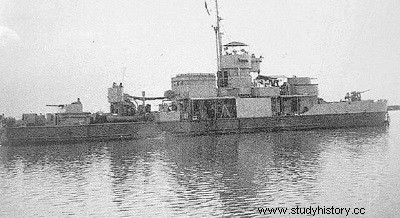
LSSL is the new designation, fortunately simplified at the same time, of the LCS(L)(3), or LCS(L).Mk3; as it is the only American-built LCS(L). (the Mk.1 and Mk.2 having been British and ephemeral), there are no more variants to differentiate within the new category, hence the name LSSL. This family of buildings is relatively recent (1944-45) and small in number compared to the others (130 units).
The general silhouette is quite similar to that of the LCI, as both types of buildings are built on the same hull plans. They also have the same propulsion system:two sets of four Gray-Marine engines hitched to two shaft lines.
Dimensions
Length: 48.30 m
Width: 7.10 m
Draft: 1.90m
Displacement
Lightweight :230 t
Full load :387 t
On-board electronics
An "SL" model radar
A DRBN30 radar
Energy - Propulsion
Motorization :four Gray-Marine engines hitched to two shaft lines.
Power :1000 CV
Speed :25.5 knots
Range :8000 nq at 12 knots
Armament (1st series):
one 76mm gun
four 40mm Bofors guns, remote controlled
four 20mm Oerlikon guns ( two on each side)
two 81mm mortars
Personnel
3 officers, 55 petty officers and crew commanded by a lieutenant.
The armament of the LSSL, very important, fully justifies the name of Support Ship, building of support; The 40 mm guns are mounted in two double carriages, each carriage being driven by a Mk.51 remote control station:it is therefore possible to fire simultaneously on two different objectives; moreover, the forward remote control station is directly adjacent to the bridge, which allows the captain to have it within his immediate field of action, without the intermediary of the telephone and whatever the disturbances caused by the din of combat ....
The LSSLs, much more efficient from the outset than the LCIs, received, for Indochina operations, significantly fewer modifications than the latter. However, the experience of the Day battle (Ninh-Binh and Yen-Cu-Ha, May 29 to June 7, 1951), where the LSSL-6 was marked by numerous impacts, shows the need to armor certain parts of the superstructures, and to protect the servants of the 76mm gun with masks; these modifications are carried out on all LSSLs, to the detriment of their nautical qualities. On the other hand, the original equipment includes a radar, model "SL", corresponding to the needs of navigation at sea and to the most common production at the time of construction of the boats (1944); the needs of river navigation, at night and in foggy weather, and operational requirements (objects such as sampans or drifting mines must be detected in all circumstances) lead to the installation of an additional radar, better suited to the problem:the small DRBN30 radar, recently produced in France.
Perhaps forgetting what the "river battleships" were, some call the LSSL "river cruisers":the name is singularly better justified!
Circumstances mean that the first six LSSLs are successively assigned, after their American serial number, two series of numbers! The final naming is intended to give them greater "dignity" (in the sense that a numbered craft is - perhaps - not a "worthy" boat).
Ancient history
